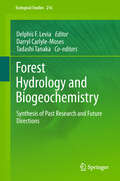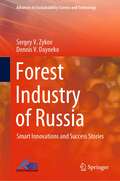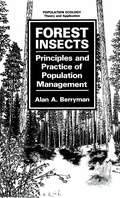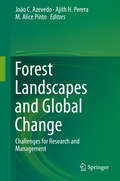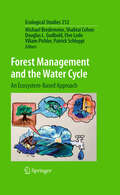- Table View
- List View
Forest Genetics and Sustainability (Forestry Sciences #63)
by Csaba MátyásDuring the 4th International Consultation on Forest Genetics and Tree Building, held in 1998 in Beijing, China, leading scientists were invited to review past achievements, to redefine the role of forest genetics and breeding in contemporary forestry, and to set priorities for future research and development. On the basis of the invited presentations, the volume summarizes the state of knowledge in various fields, such as the impact of forest management and of changing environmental conditions on genetic resources, and the value of genetic markers as indicators for adaptational potential, as well as the tasks of conservation. Detailed reports from the different continents provide a comprehensive diagnosis of the global situation of forest genetics and tree breeding research. The book offers not only an overview of contemporary trends and expected future developments, but also identifies current main problems in funding and cooperation. It may prove therefore useful not only for scientists, university lecturers and advanced students in the field of forestry, ecology and conservation biology, but also for decision makers and managers in companies and conservation organizations.
Forest Genomics and Biotechnology (CABI Biotechnology Series)
by Richard Meilan Matias KirstDevelopments in genomics and biotechnology are opening up new avenues for accelerating the domestication of forest trees in a climate change driven world. This book presents an authoritative update of forest tree biotechnology and genomics methodologies, procedures and accomplishments, from basic biological science to applications in forestry and related sciences. It gives expert evaluation of achievements and discussion about the impact that novel forest biotechnological and genomics approaches are having on traditional breeding for improvement of forest tree species and production of forest-based products. It also describes the legal and regulatory aspects of forest biotechnology, with an emphasis on biosafety. It is a reference for forest biologists, including basic and applied scientists involved in forest tree breeding and biotechnology, bioenergy research, and biomaterial product development. Key features: Advances in tree genomic selection. Next-generation sequencing technologies. Domesticating forest-tree species via genetic engineering. Regulatory affairs related to forest biotechnology. Protecting intellectual property. This title is suitable for graduate-level students working in plant biology and forest genetics, silviculture and agroforestry, and bioenergy science and technology. It is also relevant to scientists and foresters researching genetics, genomics and biotechnology, molecular biology and physiology of forest trees, and their application to production forestry, and conservation, as well as for sustainable forestry for bioenergy and bio-based products.
Forest Governance: Overcoming Trade-Offs between Land-Use Pressures, Climate and Biodiversity Protection (Volume 3) (Environmental Humanities: Transformation, Governance, Ethics, Law)
by Katharina Hagemann Felix Ekardt Jessica Stubenrauch Beatrice GarskeThis book analyses and develops overarching concepts for forest policy and forest governance and includes a detailed investigation into the historical discussion on forests. It examines opportunities and limits for negative emissions in a sector that – like peatlands – appears significantly less ambivalent compared to highly technical large-scale forms of climate geoengineering. The analysis shows that the binding climate and biodiversity targets under international law are much more ambitious than most people assume. Measured against that, the volume critically reviews the potentials of afforestation and reforestation for climate mitigation, which is often presented as the new saviour to fulfil the commitments of the Paris Agreement and to reach climate neutrality in the future. It becomes clear that ultimately only biodiverse and thus resilient forests can function as a carbon sink in the long term. The volume shows that the existing European and international forest governance approaches fail to comply with these targets and insights. Furthermore, the book develops a bundle of policy measures. Quantity governance systems for livestock farming, fossil fuels and similar drivers of deforestations represent the most important approach. They are most effective when not directly targeting forests due to their heterogeneity but central damaging factors. With regard to the dominant regulatory and subsidy-based governance for forests we show that it remains necessary to supplement these quantity governance systems with certain easily graspable and thus controllable regulatory and subsidy regulations such as a regulatory protection of old-growth forests with almost no exceptions; extension of the livestock-to-land-ratio established in organic farming to all farming; far-reaching restriction of bioenergy use to certain residues flanked by import bans; and a national and international complete conversion of all agricultural and forest subsidies to “public money for public services” to promote nature conservation and afforestation in addition to the quantity control systems.
Forest Governance and Management Across Time: Developing a New Forest Social Contract (The Earthscan Forest Library)
by Erland Mårald Camilla Sandstrom Annika Nordin and OthersThe influence of the past, and of the future on current-time tradeoffs in the forest arena are particularly relevant given the long-term successions in forest landscapes and the hundred years’ rotations in forestry. Historically established path dependencies and conflicts determine our present situation and delimit what is possible to achieve. Similarly, future trends and desires have a large influence on decision making. Nevertheless, decisions about forest governance and management are always made in the present – in the present-time appraisal of the developed situation, future alternatives and in negotiation between different perspectives, interests, and actors. This book explores historic and future outlooks as well as current tradeoffs and methods in forest governance and management. It emphasizes the generality and complexity with empirical data from Sweden and internationally. It first investigates, from a historical perspective, how previous forest policies and discourses have influenced current forest governance and management. Second, it considers methods to explore alternative forest futures and how the results from such investigations may influence the present. Third, it examines current methods of balancing tradeoffs in decision-making among ecosystem services. Based on the findings the authors develop an integrated approach – Reflexive Forestry – to support exchange of knowledge and understandings to enable capacity building and the establishment of common ground. Such societal agreements, or what the authors elaborate as forest social contracts, are sets of relational commitment between involved actors that may generate mutual action and a common directionality to meet contemporary challenges.
Forest Governance and Management Across Time: Developing a New Forest Social Contract (The Earthscan Forest Library)
by Erland Mårald Camilla Sandstrom Annika Nordin and OthersThe influence of the past, and of the future on current-time tradeoffs in the forest arena are particularly relevant given the long-term successions in forest landscapes and the hundred years’ rotations in forestry. Historically established path dependencies and conflicts determine our present situation and delimit what is possible to achieve. Similarly, future trends and desires have a large influence on decision making. Nevertheless, decisions about forest governance and management are always made in the present – in the present-time appraisal of the developed situation, future alternatives and in negotiation between different perspectives, interests, and actors. This book explores historic and future outlooks as well as current tradeoffs and methods in forest governance and management. It emphasizes the generality and complexity with empirical data from Sweden and internationally. It first investigates, from a historical perspective, how previous forest policies and discourses have influenced current forest governance and management. Second, it considers methods to explore alternative forest futures and how the results from such investigations may influence the present. Third, it examines current methods of balancing tradeoffs in decision-making among ecosystem services. Based on the findings the authors develop an integrated approach – Reflexive Forestry – to support exchange of knowledge and understandings to enable capacity building and the establishment of common ground. Such societal agreements, or what the authors elaborate as forest social contracts, are sets of relational commitment between involved actors that may generate mutual action and a common directionality to meet contemporary challenges.
Forest Growth Responses to the Pollution Climate of the 21st Century
by J. NeilCape Lucy J. SheppardThis Special Issue of Water, Air and Soil Pollution offers contributions from the th 18 IUFRO workshop on Air Pollution Stress, Forest Responses to the Pollution st Climate of the 21 Century held in Edinburgh, Scotland, from September 21 to 23,1998. The meeting was held under the auspices of IUFRO, Research Group 7.04.00 chaired by Dr Kevin Percy of Canada. A new session structure was adopted to stimulate activity within the six working parties and a brief resume of these is presented at the front of this volume. The two, one-day plenary sessions were devoted to the two important air pollution issues, nitrogen deposition and ozone. Invited papers were augmented by a large and excellent contribution of poster papers. The final day comprised parallel Working Party Sessions with pre arranged speakers to stimulate discussions. One hundred and thirty one scientists attended, representing 20 countries and 7 IUFRO regions: Northern Europe, Central Europe, Eastern Europe, Mediterranean, North America, Asia and the Western Pacific. Lucy Sheppard David Fowler Water, Air, and Soil Pollution 116: 1, 1999.
Forest Hydrology: Processes, Management and Assessment
by Devendra M. Amatya Thomas M. Williams Leon Bren Carmen JongForests cover approximately 26% of the world's land surface area and represent a distinct biotic community. They interact with water and soil in a variety of ways, providing canopy surfaces which trap precipitation and allow evaporation back into the atmosphere, thus regulating how much water reaches the forest floor as through fall, as well as pull water from the soil for transpiration. The discipline "forest hydrology" has been developed throughout the 20th century. During that time human intervention in natural landscapes has increased, and land use and management practices have intensified. This book: - Presents cutting edge thinking and assessments in forest hydrology across all latitudes and terrains, including state-of-the-art modelling techniques and methodologies - Describes the latest challenges facing forest hydrology, such as increased occurrence of disturbance, due to extreme floods, drought, disease, and fire, potentially caused by climate change - Is written by an internationally renowned team of scientists, engineers, and managers to give a well-rounded review of the subject The book will be useful for graduate students, professionals, land managers, practitioners, and researchers with a good understanding of the basic principles of hydrology and hydrologic processes.
Forest Hydrology: An Introduction to Water and Forests, Third Edition
by Mingteh ChangDue to its height, density, and thickness of crown canopy; fluffy forest floor; large root system; and horizontal distribution; forest is the most distinguished type of vegetation on the earth. In the U.S., forests occupy about 30 percent of the total territory. Yet this 30 percent of land area produces about 60 percent of total surface runoff, the
Forest Hydrology and Biogeochemistry: Synthesis of Past Research and Future Directions (Ecological Studies #216)
by Delphis F. Levia, Darryl Carlyle-Moses and Tadashi TanakaThis international rigorously peer-reviewed volume critically synthesizes current knowledge in forest hydrology and biogeochemistry. It is a one-stop comprehensive reference tool for researchers and practitioners in the fields of hydrology, biogeoscience, ecology, forestry, boundary-layer meteorology, and geography. Following an introductory chapter tracing the historical roots of the subject, the book is divided into the following main sections:· Sampling and Novel Approaches· Forest Hydrology and Biogeochemistry by Ecoregion and Forest Type· Hydrologic and Biogeochemical Fluxes from the Canopy to the Phreatic Surface· Hydrologic and Biogeochemical Fluxes in Forest Ecosystems: Effects of Time, Stressors, and HumansThe volume concludes with a final chapter that reflects on the current state of knowledge and identifies some areas in need of further research.
Forest Hydrology and Catchment Management: An Australian Perspective
by Leon BrenFor the last three centuries forests have been recognised as providing the best water catchments and valued for their sustained output of high quality water. In Australia, work which was commenced fifty years ago has come to fruition and is providing new information on forest hydrology issues. The book focusses on the issues of small streams, including catchment definition, slope, hydrograph formation, water quality measurement, and annual water yield. The world-wide management issues of sustaining riparian forests are examined, using the River Murray forests as an example. Finally a large amount of information is drawn together to examine the management of forested catchments for water supplies. This book presents an incisive, disciplined, quantitative approach to dealing with forest hydrology matters. Although world-wide in application, the book particularly draws on Australian studies. It is written with the needs of students and forest practitioners in mind.
Forest Hydrology and Catchment Management: An Australian Perspective
by Leon BrenThis book provides scientific evidence to underline the notion that forests offer the most reliable water catchments in the natural environment. The unique Australian ecosystem provides valuable information on the water yields and hydro-ecology of forests. Insights can be transferred to other climate zones and conditions. In this second edition, the author puts a particular focus on the most prominent challenges of our time, in relation to water management. Ground salinity, climate change, and droughts have all been newly added to this updated edition. One of the most important concepts is highlighting the accumulated contribution of smaller catchments and minor streams. Finally, readers will also get information on the economic dimension of water management. With its incisive, disciplined, and quantitative (and occasionally humorous) approach, this book helps scientists, students, and regulators to understand water-driven conflicts and offers guidance on management.
Forest Hydrology and Ecology at Coweeta (Ecological Studies #66)
by Wayne T. Swank D. A. Jr. CrossleyCoweeta is one of the oldest continuously operating laboratories of its type in the world. For the first time, a complete review and summary of more than 50 years study of the hydrological and ecological responses of baseline and managed Southern Appalachian hardwood forests at Coweeta is now supplied by this volume. The long-term research approach represents a continuum of theory, experimentation and application using watersheds as landscape units of investigation. Thus, the information encompasses a wide range of interpretations and interests. In addition to in-depth analyses of terrestrial and stream processes, the breadth of coverage includes historical perspectives and relevance of ecosystem science to management needs. In a broader sense, the Coweeta research effort is considered from a perspective of national and international forest hydrology and ecology programs.
Forest Industry of Russia: Smart Innovations and Success Stories (Advances in Sustainability Science and Technology)
by Sergey V. Zykov Dennis V. DaynekoThis book focuses on crisis management in forest industry of Russia. It is about the present, and the future, with a short retrospective about the past of the forest industry in Russia. It includes forecasting too and description of some of the best practices of developed countries to be implemented in Russia to overcome the crisis. The main theme of the book is smart innovations and innovative activities introduced and also those which are required in the forest industry of Russia. The book considers the effectiveness of innovations and institutional changes in the forest industry, which are an important direction of innovation activities required all together with technological and economic breakthrough with ecological aspects in priority. The necessity to implement the modern innovation system in the forest industry based on institutional changes is substantiated and thoroughly explained with successful examples of ongoing and future up-to-date smart innovations. The development of the forest innovation system is suggested for sustainable forest industry management; the key components of which are technological, product, institutional, and ecological innovations, as well as, innovative entrepreneurship. Realization of the innovation system for technological and intellectual improvement requires good scientific and personnel provision, anticipation of markets and tendencies of development for some decades ahead. The implied advanced technologies in the forest industry also include IT-, nano-, and biotechnologies. The success stories of the leading Russian and international companies in the forest industry of Russia are studied attentively in the book. The book presents a profound methodical and theoretical substantiation for the further implementation of the smart innovations and of the successful experience of the industry leading companies.
Forest Insects: Principles and Practice of Population Management (Population Ecology)
by Alan A. BerrymanThis book is intended as a general text for undergraduates studying the manage ment of forest insect pests. It is divided into four parts: insects, ecology, manage ment, and practice. Part I, Insects, contains two chapters. The first is intended to provide an overview of the general attributes of insects. Recognizing that it is impossible to adequately treat such a diverse and complex group of organisms in such a short space, I have attempted to highlight those insectan characteristics that make them difficult animals to combat. I have also tried to expose the insects' weak points, those attributes that make them vulnerable to manipulation by human actions. Even so, this first chapter will seem inadequate and sketchy to many of my colleagues. Ideally, this book should be used in conjunction with a laboratory manual covering insect anatomy, physiology, biology, behavior, and classifica tion in much greater depth-in fact, this is how I organize my forest entomology course. It is hoped that this first chapter will provide nonentomologists with a general feel for the insects and with a broad understanding of their strengths and weaknesses, while Chapter 2 will provide a brief overview of the diverse insect fauna that attacks the various parts of forest trees and their products.
Forest Inventory: Methodology and Applications (Managing Forest Ecosystems #10)
by Annika Kangas Matti MaltamoThis book has been developed as a forest inventory textbook for students and could also serve as a handbook for practical foresters. We have set out to keep the mathematics in the book at a fairly non-technical level, and therefore, although we deal with many issues that include highly sophisticated methodology, we try to present first and foremost the ideas behind them. For foresters who need more details, references are given to more advanced scientific papers and books in the fields of statistics and biometrics. Forest inventory books deal mostly with sampling and measurement issues, as found here in section I, but since forest inventories in many countries involve much more than this, we have also included material on forestry applications. Most applications nowadays involve remote sensing technology of some sort, so that section II deals mostly with the use of remote sensing material for this purpose. Section III deals with national inventories carried out in different parts of world, and section IV is an attempt to outline some future possibilities of forest inventory methodologies. The editors, Annika Kangas Professor of Forest Mensuration and Management, Department of Forest Resource Management, University of Helsinki. Matti Maltamo Professor of Forest Mensuration, Faculty of Forestry, University of Joensuu. ACKNOWLEDGEMENTS
Forest Inventory-based Projection Systems for Wood and Biomass Availability (Managing Forest Ecosystems #29)
by Susana Barreiro Mart-Jan Schelhaas Ronald E. McRoberts Gerald KändlerThis book provides detailed descriptions of the forest biomass projection systems used in 22 countries in Europe and North America, as well as four European-wide systems. Separate chapters focus on the concepts of estimation of availability of woody biomass, compare and classify the different projection systems, and discuss the challenges and opportunities for the further development of these systems.
Forest Landscape Ecology: Transferring Knowledge to Practice
by Ajith H. Perera Lisa Buse Thomas CrowLandscape ecology has generated a wealth of knowledge that could enhance forest policy, but little of this knowledge has found its way into practice. This the first book to introduce landscape ecologists to the discipline of knowledge transfer. The book considers knowledge transfer in general, critically examines aspects that are unique to forest landscape ecology, and reviews case studies of successful applications for policy developers and forest managers in North America.
Forest Landscape Restoration: Integrating Natural and Social Sciences (World Forests #15)
by John Stanturf, David Lamb and Palle MadsenRestoration ecology, as a scientific discipline, developed from practitioners’ efforts to restore degraded land, with interest also coming from applied ecologists attracted by the potential for restoration projects to apply and/or test developing theories on ecosystem development. Since then, forest landscape restoration (FLR) has emerged as a practical approach to forest restoration particularly in developing countries, where an approach which is both large-scale and focuses on meeting human needs is required.Yet despite increased investigation into both the biological and social aspects of FLR, there has so far been little success in systematically integrating these two complementary strands. Bringing experts in landscape studies, natural resource management and forest restoration, together with those experienced in conflict management, environmental economics and urban studies, this book bridges that gap to define the nature and potential of FLR as a truly multidisciplinary approach to a global environmental problem. The book will provide a valuable reference to graduate students and researchers interested in ecological restoration, forest ecology and management, as well as to professionals in environmental restoration, natural resource management, conservation, and environmental policy.
The Forest Landscape Restoration Handbook
by Stewart Maginnis Jennifer Rietbergen-McCracken Alastair SarreForest loss and degradation have caused a decline in the quality of ecosystem services around the world. But fixing the problem takes more than just planting trees; practitioners increasingly realize that a landscape approach is essential. This handbook, authored and edited by international authorities in the field of forestry, is the first practical guide to using forest landscape restoration (FLR) to repair the damage done to forest lands by poor land management practice. Using research backed by respected institutions such as ITTO and the World Conservation Union (IUCN), it explains how to increase the resilience of landscapes and the communities they support through FLR. The main aim of FLR is not to re-establish pristine forest, even if this were possible; rather, the objective is to make landscapes more resilient and thereby keep future management options open. It also aims to support communities as they strive to increase and sustain the benefits they derive from land management. This book explains the concept of FLR and guides the reader through the steps that must be taken to put it into practice. It is an indispensable aid for practitioners in all aspects of forestry and natural resource management.
The Forest Landscape Restoration Handbook (The\earthscan Forest Library)
by Jennifer Rietbergen-McCracken Stewart Maginnis Alastair SarreForest loss and degradation have caused a decline in the quality of ecosystem services around the world. But fixing the problem takes more than just planting trees; practitioners increasingly realize that a landscape approach is essential. This handbook, authored and edited by international authorities in the field of forestry, is the first practical guide to using forest landscape restoration (FLR) to repair the damage done to forest lands by poor land management practice. Using research backed by respected institutions such as ITTO and the World Conservation Union (IUCN), it explains how to increase the resilience of landscapes and the communities they support through FLR. The main aim of FLR is not to re-establish pristine forest, even if this were possible; rather, the objective is to make landscapes more resilient and thereby keep future management options open. It also aims to support communities as they strive to increase and sustain the benefits they derive from land management. This book explains the concept of FLR and guides the reader through the steps that must be taken to put it into practice. It is an indispensable aid for practitioners in all aspects of forestry and natural resource management.
Forest Landscapes and Global Change: Challenges for Research and Management
by João C. Azevedo Ajith H. Perera M. Alice PintoClimate change, urban sprawl, abandonment of agriculture, intensification of forestry and agriculture, changes in energy generation and use, expansion of infrastructure networks, habitat destruction and degradation, and other drivers of change occur at increasing rates. They affect patterns and processes in forest landscapes, and modify ecosystem services derived from those ecosystems. Consequently, rapidly changing landscapes present many new challenges to scientists and managers. While it is not uncommon to encounter the terms “global change” and “landscape” together in the ecological literature, a global analyses of drivers of change in forest landscapes, and their ecological consequences have not been addressed adequately. That is the goal of this volume: an exploration of the state of knowledge of global changes in forested landscapes with emphasis on causes and effects, and challenges faced by researchers and land managers. Initial chapters identify and describe major agents of landscape change: climate, fire, and human activities. The next series of chapters address implications of changes on ecosystem services, biodiversity conservation and carbon flux. A chapter that describes methodologies of detecting and monitoring landscape changes is presented followed by chapter that highlights the many challenges forest landscape managers face amidst of global change. Finally, we present a summary and a synthesis of the main points presented in the book. Each chapter will contain the individual research experiences of chapter authors, augmented by review and synthesis of global scientific literature on relevant topics, as well as critical input from multiple peer reviewers.
Forest Management and the Water Cycle: An Ecosystem-Based Approach (Ecological Studies #212)
by Michael Bredemeier, Shabtai Cohen, Douglas L. Godbold, Elve Lode, Viliam Pichler and Patrick SchleppiThe protective function of forests for water quality and water-related hazards, as well as adequate water supplies for forest ecosystems in Europe, are potentially at risk due to changing climate and changing land-management practices. Water budgets of forest ecosystems are heavily dependent on climate and forest structure. The latter is determined by the management measures applied in the forestry sector. Various developments of forest management strategies, imposed on a background of changing climate, are considered in assessing the overall future of forest–water interactions in Europe.Synthesizing recent research on the interactions of forest management and the water regime of forests in Europe and beyond, the book makes an important contribution to the ongoing dialogue between scientists dealing with different scales of forest-water interactions. This collaborative endeavour, which covers geographic and climatic gradients from Iceland to Israel and from southern Spain to Estonia and Finland, was made possible through the COST Action "Forest Management and the Water Cycle (FORMAN)", which was launched in 2007 (http://www.forestandwater.eu/). The book will be of particular interest to the research community involved in forest ecosystem research and forest hydrology, as well as landscape ecologists and hydrologists in general. It will also provide reference material for forest practitioners and planners in hydrology and land use.
Forest Management Auditing: Certification of Forest Products and Services (Earthscan Studies in Natural Resource Management)
by Lucio Brotto Davide PettenellaForest management auditing is expanding from its traditional focus on forest management, stewardship and Chain of Custody certification to more innovative topics such as ecosystem services, forest carbon credits, Non-Wood Forest Products, wood energy and Fair Trade certification. Forest managers, auditors and project developers require a new range of skills, capacities and expertise to monitor these issues. This book outlines the market-based tools that are required by such professionals to ensure corporate social responsibility in the forestry sector. It shows how a mutual learning process between established forest certification processes and innovative markets is needed. It addresses key topics such as High Conservation Value (HCV) approaches, the role of independent certification versus due diligence process and the engagement of smallholders and SMEs. Beginning with a market and policy analysis, the book fosters a deeper understanding of standards, methodologies and auditing techniques. Numerous case studies are included from a wide range of contexts, including both temperate and tropical forests in developed and developing countries. Overall, the book analyses all the steps towards forest management and forest products and services certification.
Forest Management Auditing: Certification of Forest Products and Services (Earthscan Studies in Natural Resource Management)
by Lucio Brotto Davide PettenellaForest management auditing is expanding from its traditional focus on forest management, stewardship and Chain of Custody certification to more innovative topics such as ecosystem services, forest carbon credits, Non-Wood Forest Products, wood energy and Fair Trade certification. Forest managers, auditors and project developers require a new range of skills, capacities and expertise to monitor these issues. This book outlines the market-based tools that are required by such professionals to ensure corporate social responsibility in the forestry sector. It shows how a mutual learning process between established forest certification processes and innovative markets is needed. It addresses key topics such as High Conservation Value (HCV) approaches, the role of independent certification versus due diligence process and the engagement of smallholders and SMEs. Beginning with a market and policy analysis, the book fosters a deeper understanding of standards, methodologies and auditing techniques. Numerous case studies are included from a wide range of contexts, including both temperate and tropical forests in developed and developing countries. Overall, the book analyses all the steps towards forest management and forest products and services certification.
Forest Management for Climate Change Mitigation: Recent Innovations and Research Needs (The Handbook of Environmental Chemistry #132)
by Paulo Pereira Yixiang Wang Manuel Esteban Lucas Borja Zhibin SunThis book reviews the most recent research on soil, vegetation, and ecosystems within forestry landscapes under the pressures of climate change. It also explores the interplay between climate change, forest ecology, and human interventions. Covering a diverse array of topics such as carbon sequestration, wildfire impacts, soil biogeochemistry, and methane emissions, the book incorporates scientific research and management strategies to provide a holistic understanding of the challenges and opportunities for forest management amidst climate change. In this book, readers will find the most up-to-date afforestation and forest management techniques for controlling greenhouse gas (GHG) emissions and carbon sequestration in the forestry system. The readers of this book will gain a new perspective on forests by learning about new forestry techniques, forest vegetation change, natural and artificial disturbances, soil greenhouse gases, and soil chemistry, all while emphasizing the critical relationship between Environmental Chemistry and Forestry. Focusing on the practices of the Asia-Pacific Network for Sustainable Forest Management and Rehabilitation (APFNet) Projects, the book offers insights into practical approaches and solutions for addressing climate change within forest ecosystems and provides evidence-based recommendations for sustainable forest management and adaptation strategies. This unique volume, which includes contributions from respected scholars, emphasizes the importance of interdisciplinary collaboration in addressing the complex challenges posed by climate change in forest ecosystems. It also aims to raise awareness among forestry researchers, officials, and policymakers about the growing importance of forest ecosystems as a result of global climate change.







